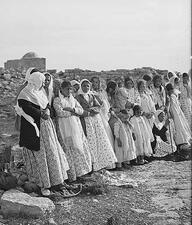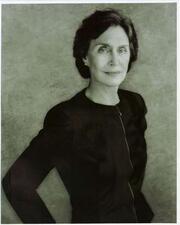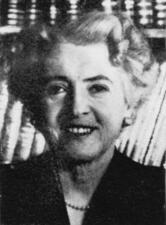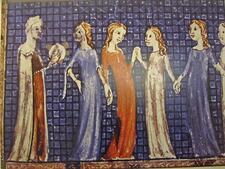Family: Marriage

Poverty: Jewish Women in Medieval Egypt
The documents recovered from the Cairo Genizah give insight into the lives of Jewish women in poverty in medieval Egypt. Without husbands, women were often left without any means of earning a living, though the Jewish community assumed responsibility for providing for widows.
Qumran
Whether or not women were a part of the Essenes’ Qumran settlement, they do appear in Qumran literature. Women in the halakhic writing are only discussed when there are explicit rulings about women’s issues. Halakhic literature shows that women were excluded from all facets of public life and generally were subject to strict halakhic rulings.
Rachel, Wife of Rabbi Akiva
Rachel is the name given to the wife of Rabbi Akiva in medieval sources. Various stories in rabbinic literature depict her as supporting her husband in his efforts to study Torah with great personal sacrifice.

Rachel: Bible
The younger daughter of Laban and wife of Jacob, Rachel is the mother of Joseph and Benjamin, who become two of the twelve tribes of Israel (Gen 35:24; 46:15–18). Rachel, who died young, becomes an image of tragic womanhood. After the biblical period, “Mother Rachel” continued to be celebrated as a powerful intercessor for the people of Israel.

Rachel: Midrash and Aggadah
Rachel is depicted in the Torah as Jacob’s beautiful and beloved wife. The midrash portrays Rachel as a prophetess, and her statements and the names she gave her sons contain allusions to the future. Rachel’s merit continued to aid Israel even many years after her demise.

Rashi
The medieval commentator Rashi, through his commentary and halakhic works, was an advocate for improving the status of women, introducing innovative exegesis to support his views. His followers, the Tosafists, would continue to innovate and support Jewish women.

Rebekah: Bible
Rebekah is the second matriarch in Genesis and shares two problems with Sarah, the first matriarch: barrenness, and being passed off as her husband’s sister. But her story is more extensive; she is a dynamic character in a long narrative describing how she becomes Isaac’s wife. Her agency continues when she bears twins and secures the birthright for her favored son.

Rebekah: Midrash and Aggadah
Rebekah, one of the four Matriarchs, is characterized by the Rabbis as a prophet and a righteous woman. The midrash transforms Rebekah from an individual character with a personal story into a symbol of the realization of God’s promise to Abraham.
Reproductive Technology, New (NRT)
New reproductive technology has provided the solution for problems of infertility for hundreds of thousands of couples. For halakhically observant Jews, especially in the pro-natal state of Israel and in general in the post-Holocaust era, this technology has been a blessing but has also created a multitude of halakhic problems.

Sarah Rodrigues Brandon
Sarah Rodrigues Brandon (1798-1828) was born poor, enslaved, and Christian on the island of Barbados. By the time of her death thirty years later she was one of the wealthiest Jews in New York and her family were leaders in Congregation Shearith Israel. This entry explains Sarah’s life journey and highlights how her story relates to that of other women of mixed African and Jewish ancestry in early America.
Russian Immigrants in Israel
Approximately 350,000 Jewish women moved to Israel from the Former Soviet Union after 1989. Among the key issues they faced were occupational downgrading, sexuality and family life, sexual harassment, marital distress, and single-parent families.
Salome

Samaritan Sect
Sex
She'erit ha-Peletah: Women in DP Camps in Germany
Family played an important role in the lives of Holocaust survivors in DP (displaced persons) camps – in 1947, the birth rate in DP camps was one of the highest in the world. Women served as teachers and eager students, and they were active in the effort to open immigration to Palestine.

Judith Sheindlin
For two and half decades, former New York family court Judge Judith Sheindlin has riveted daytime viewers, racked up awards, and sold thousands of books to people hungry for the tough love of a tough Jewish mother. Millions of viewers who watch Judge Judy every day are treated to many Yiddish words and wisdom the jurist uses on a parade of deserving participants who enter her TV studio courtroom.
Shelomith 1: Midrash and Aggadah

Alix Kates Shulman
Alix Kates Shulman is a radical feminist writer and activist and a leader in the second-wave feminist movement of the 1960s through 1980s. She is best known as the author of “The Marriage Agreement” (1970) and the best-selling Memoirs of an Ex-Prom Queen (1972), which was heralded as the “first important novel of the Women’s Liberation movement.” She was honored with a Clara Lemlich Award for a lifetime of social activism in 2018.
Benjamin Aron Slonik
Benjamin Aron Slonik, a Polish rabbi and student of the Maharshal and Rema, was notable for his independent approach to halakha. His rulings often went against his colleagues, including on women’s halakhot.
Sociodemography
Over the last several decades, Jewish women attained significant achievement in the socio-economic sphere and played a leading role in maintaining Jewish continuity. In general, Jewish women are educated and participate in the labor force at higher rates than their non-Jewish counterparts.

Bertha Solomon
Sotah
Sotah, Tractate

Medieval Spain
Written histories of Jews in medieval Spain rarely include women, so one must seek alternate sources. Marital status was the frequent topic of rabbinic responsa. Some Jewish women made their own income as merchants and moneylenders. Inheritance laws were problematic for Jewish women – disputes were settled in both Jewish and non-Jewish courts.


